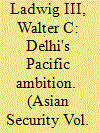|
|
|
Sort Order |
|
|
|
Items / Page
|
|
|
|
|
|
|
| Srl | Item |
| 1 |
ID:
089062


|
|
|
|
|
| Publication |
2009.
|
| Summary/Abstract |
While India may not traditionally be considered to be a significant actor in the Asia-Pacific region, over the past 18 years, New Delhi has undertaken a concerted effort to direct its foreign, economic, and military policies eastward. What began as economic cooperation with the nations of Southeast Asia has expanded into full-spectrum engagement with the major powers of East Asia. This article explores India's emergence in the Asia-Pacific, concluding that, while in the near term India's presence and influence will be felt most strongly in Southeast Asia, a steadily expanding economy, paired with a growing partnership with key regional actors and an increasingly capable Navy, positions the South Asian giant to have an impact on the emerging security architecture of the region.
|
|
|
|
|
|
|
|
|
|
|
|
|
|
|
|
| 2 |
ID:
147047


|
|
|
|
|
| Summary/Abstract |
After a decade and a half of counterinsurgency operations in Iraq and Afghanistan, U.S. policymakers want to change their approach to COIN by providing aid and advice to local governments rather than directly intervening with U.S. forces. Both this strategy and U.S. counterinsurgency doctrine in general, however, do not acknowledge the difficulty of convincing clients to follow U.S. COIN prescriptions. The historical record suggests that, despite a shared aim of defeating an insurgency, the United States and its local partners have had significantly different goals, priorities, and interests with respect to the conduct of their counterinsurgency campaigns. Consequently, a key focus of attention in any future counterinsurgency assistance effort should be on shaping the client state's strategy and behavior. Although it is tempting to think that providing significant amounts of aid will generate the leverage necessary to affect a client's behavior and policies, the U.S. experience in assisting the government of El Salvador in that country's twelve-year civil war demonstrates that influence is more likely to flow from tight conditions on aid than from boundless generosity.
|
|
|
|
|
|
|
|
|
|
|
|
|
|
|
|
|
|
|
|
|